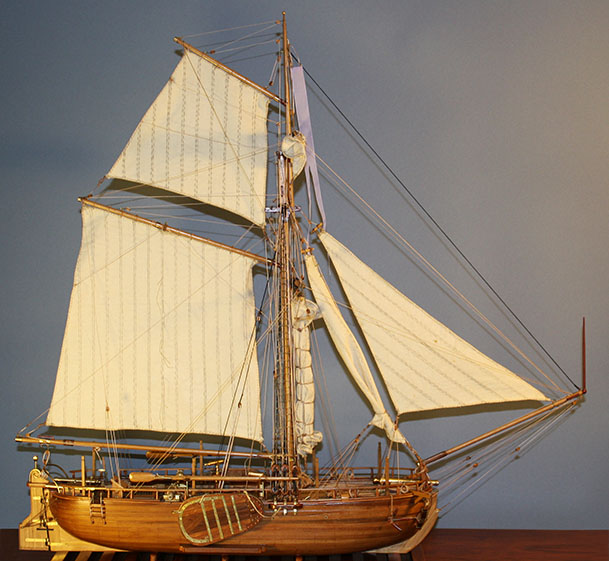Van Speijk’s Gunboat Number 2
Particulars
Vessel type: Dutch sloop rigged shallow draft gunboat
Builder: Not known
Date Delivered: Not known
Date Scrapped: Blew up and sank February 5, 1831
Length on deck: about 71 feet
Length over all: about 104 feet
Beam: about 22 feet across the leeboards
Depth: about 10 feet
Draft: about 5 feet
Maximum Displacement: about 150 tons
Construction Material: Wood, probably oak keel, frames and hull planking.
Rig Type: Gaff rigged sloop with gaff topsail and square sails
Sail area: About 3,500 square feet
Crew Size: 31
Propulsion: Sail (oar in light air)
Cruising Speed: about 6 knots
Maximum Speed: about 9 knots
Armament: One 30 pounder cannon, two 24 pounder cannons and various swivel guns
Vessel Description
A gunboat is generally a small vessel fitted with a large gun. The vessel’s intended use is in-shore bombardment, and possibly defensive bombardment from shallow water to vessels in deeper water. This particular vessel is a sailing gunboat based on a traditional Dutch vessel shallow draft designs. Literally thousands of vessels of this size and shape were built for the Dutch inland and coastal commercial cargo trade. Their wide beam, relatively low freeboard and sturdy construction also made them perfectly suitable to carry guns on deck.
The Dutch used gunboats very similar in appearance to this vessel for hundreds of years with only minor changes over the years.
This particular vessel was quite heavily armed for her size with a 30 pound forward facing gun and two somewhat lighter aft facing guns. In addition she was also fitted with a number of swivel guns. In commercial service these vessels were fitted with a simple sloop rig consisting of a gaffed main sail and a few jibs. It appears that, for naval service, she was rigged with a more complex rig that allowed her to carry more sail when conditions allowed.
The vessel is basically flat bottomed which gives a very shallow draft and the leeboards on each side which, when lowered, provide the side force that keeps her from being set sideways when sailing to windward. While the hull is not particularly sleek, boats of this design are quite respectable sailors, and boats of this design continue to be sailed as historical, coastal passenger and recreational vessels in Holland in large numbers to this day.
This vessel was probably built of oak with heavy keel and frames. The oak planking in the bow and stern was bent by steaming the wood in large steam vats and then bending the softened wood to the hull frames. The captain’s cabin would have been in the stern, with midship stores space (including gunpowder storage), a galley stove just aft of the mast and crew space forward of the mast.
This model is fitted with long sweeps (oars) and in still air it would be possible to move the vessel at slow speeds. The model is not shown with a launch or boat, but probably towed a launch that could be used to board other vessels during inspections.
It is interesting to note that the gunboat concept evolved from vessels like this into the American Civil War Monitor design only thirty years later. While this vessel was completely sail powered without armor and without gun crew protection, the Monitor was completely steam powered, with guns that could be aimed in any direction of the ship and was fitted with armor that provided full protection for the ship and crew. Quite a leap forward in the gunboat concept and by 1865 sailing gunboats were obsolete.
Vessel History
During the 1830s Belgians revolted against King William of the Netherlands, who deployed naval forces against them. Lieutenant Jan van Speijk of Gunboat No. 2 patrolled the Scheldt River near Antwerp, where the vessel was tasked with stopping and inspecting vessel leaving and entering the Port of Antwerp. On February 5, 1831, strong winds blew the gunboat onto the shores and despite the efforts by the crew the vessel was stuck. A vessel master is always very careful not to be carried onto the shore by tide or wind and while reportedly the wind was quite strong, to be pinned on a leeward shore is rather embarrassing. Various accounts of the incident note that the anchor had failed and that another attempt to bring an anchor out towards deeper water using a smaller boat was prevented by the boarding Belgians. Van Speijk had vowed that he would not surrender his vessel under any circumstances. Under the imminent threat of capture, van Speijk spoke to the cabin boy calmly about not surrendering the vessel, which gave warning to the cabin boy that he’d better get as far from the vessel as possible. According to the legend van Speijk used a cigar to light a barrel of gunpowder below decks (or maybe he fired his pistol into the gunpowder) and the resulting explosion killed twenty-eight of the thirty-one crew members and an unknown amount of Belgians. The cabin boy was one of the survivors.
Van Speijk became a national hero to the Netherlands with his martyrdom immortalized in paintings and a special war hero’s grave. The King of Holland declared that there should always be a Dutch ship named van Speijk in the Dutch Navy and a Dutch warship carries his name to this day as a reminder of his self-sacrifice. The van Speijk lighthouse in Egmond aan Zee also serves as a memorial to his deed. Various parts of the vessel were recovered and are kept in various Dutch historical collections (including what is reported to be the mast of the gunboat at the Dutch Naval Academy in Den Helder).
Technical Model Description
This model was built from a Mantua kit by Henry Scheafer in 2000. The model is a plank on builder’s bulkhead model, with planking strakes that are quite similar to an actual vessel of this type. While undoubtedly van Speijk’s vessel resembled this design, it is not known if this model is an interpretation or based on the actual drawings for the subject vessel.
Model Scale: 1:43


